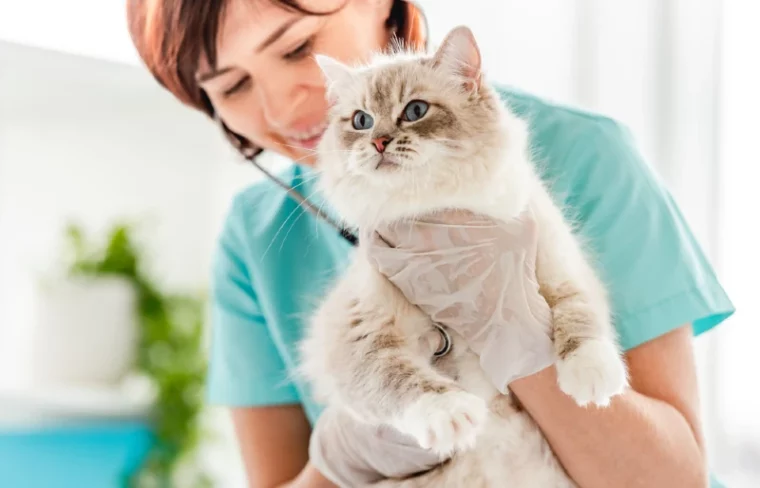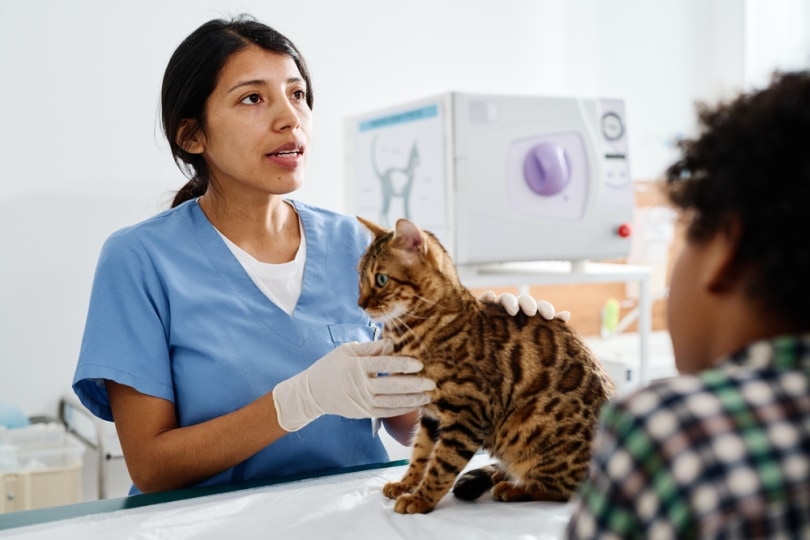
Click to Skip Ahead
Feline Lower Urinary Tract Disease (FLUTD)1 refers to a series of painful conditions, ranging from urinary tract infections to cancer, that can affect a cat’s lower urinary tract, which includes the bladder and the urethra. The buildup of bacteria in the urethra, bladder stones, or crystals in the urethra can all cause painful blockages in your cat, which can lead to death if left untreated.
An appointment with a veterinarian is needed to properly diagnose which FLTUD issues your cat is experiencing so that it can receive proper treatment. Urinary treatment costs can vary based on the severity of your cat’s case, but generally, you can expect to pay $200-$500 for an uncomplicated UTI, $1,400-$4,000 for bladder stones treatment, or $1,200 to $5,000 for obstruction treatment. We’ve compiled a list of potential prices to help you plan for a FLTUD emergency.

The Importance of Cat Urinary Treatment
Proper care and treatment are going to be very important if your cat is experiencing FLTUD symptoms. Cats experiencing urinary tract issues may have crystals forming in their urethra or bladder, leading to painful blockages, discomfort, and even death if their urethra is totally obstructed.
Signs of urinary issues in cats include trying to urinate frequently with no urine output (or very little), bloody urine, lethargy, or vomiting. Many cats also start to urinate in other areas of the home, such as bathtubs, sinks, and your clean laundry.
If your cat is experiencing any of these symptoms or behaviors, it’s important to reach out to your veterinarian as soon as you notice an issue. There are several different types of FLUTD, so your vet may have to perform a series of tests to identify the exact FLUTD issue the cat is experiencing.

The 4 Types of Feline Lower Urinary Tract Disease (FLUTD)
- Urinary Tract Infection (UTI): A UTI is a frequent cause of urinary issues in domestic cats, especially female cats. Bacteria colonize in the bladder or urethra—and cats will strain to pee, but only a tiny amount of urine, or none at all, will be expelled.
- Bladder Stone (urolithiasis): Some cats may experience bladder stones when they have a UTI. Stones are believed to be caused by a combination of genetics and diet, and can vary from painful to life-threatening. Urine is blocked from exiting the urethra, which can cause death.
- Feline Idiopathic Cystitis (FIC): Cats experiencing FIC will have inflammation of the bladder without the presence of stones or bacteria. It can be very severe and male cats may experience obstruction of the urethra.
- Bladder or Urethra Cancer: It’s rare to find a case of bladder or urethra cancer in cats, but it can occur, and exclusory tests are performed to rule it out.

How Much Does Cat Urinary Treatment Cost?
Treatment for cat urinary can vary depending on the underlying FLUTD issue your cat is experiencing. A visit to the veterinarian is a necessity, as trying to treat your cat’s symptoms on your own when dealing with a blocked urethra can result in death. The costs for cat urinary treatment can vary a little from practice to practice, but costs for treatment are roughly the same throughout the United States.
Treating UTIs
An uncomplicated UTI will typically cost between $200 to $500, which usually includes the cost of the vet visit, urinalysis, x-rays (if needed), antibiotics, and possibly a prescription urinary diet. After the UTI is treated, many veterinarians recommend a prescription urinary diet, which can include canned food, or special dry food—which can cost between $60 to $100, depending on the needs of your cat.
Non-surgical treatment with a catheter may be needed, which can cost between $750 and $1,500, if the cat doesn’t develop another obstruction. This price will usually include the vet visit, diagnostic tests, urine sample testing, and prescription diet.

Treating Bladder Stones
A cystotomy is a procedure for bladder stone removal that can cost pet owners a fair amount of money based on the severity of the bladder stones involved. The costs vary across the country due to a variety of issues, including pre-and post-operation medications, ultrasounds, x-rays, hospitalization, etc. Cystotomy will typically cost anywhere between $1,400-$4,000, depending on the previously discussed factors.
Treating Recurring Blockages
If the cat has multiple obstructions over time, a surgery called perineal urethrostomy (PU) will need to be performed to treat recurrent blockage of the urethra. A PU surgery makes the urethra wider, causing fewer blockages.
However, there is no guarantee that a cat will not experience blockages again in their life. The costs for this procedure, along with medications, hospitalization, the procedures, diagnostics, etc. typically run between as low as $1,200 to $5,000, based on the severity of your cat’s case.

Top 4 Ways to Reduce FLTUD in Cats
Once your cat experiences a urinary issue, such as a UTI or blockage, there is a significant chance that your favorite feline will experience another urinary issue again.
Does Pet Insurance Cover Cat Urinary Treatment?
Pet owners who insured their cats from a young age are more likely to have urinary treatments covered as part of their accident and illness coverage with their pet insurance company. Getting coverage early, while your pet is still young and healthy, means that if your cat develops any FLUTD issues, they’re not considered pre-existing conditions. Call your pet insurance company to check if they’ll cover urinary issues if your cat is displaying symptoms of FLUTD.
If your cat recently had a FLUTD issue, it may be difficult to get coverage, as many of the associated urinary issues are considered pre-existing, and the insurance won’t cover them. Some pet insurances are now covering curable pre-existing conditions, such as a bladder or urinary tract infection, if the condition was treated and cured within 180-365 days of obtaining coverage. Bladder crystals and urinary blockages are usually considered incurable pre-existing conditions, and will not be covered by new pet insurance policies.

Conclusion
Feline Lower Urinary Tract Disease (FLUTD) can be a very scary thing when it happens to your cat, and urinary treatment can be expensive. Proper treatment by a licensed veterinarian is the only way to ensure the best health outcome for your cat, so it can continue to live a long and healthy life. We hope our updated price guide helps you prepare for the costs associated with the life-saving veterinary care your cat needs if they experience a FLTUD health issue.
Featured Image Credit: Tatyana Vyc, Shutterstock






